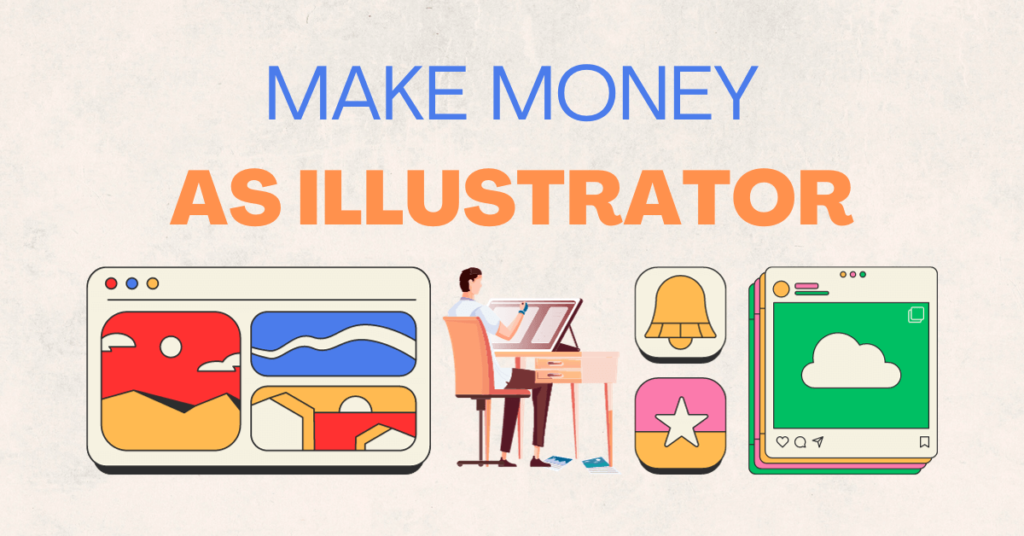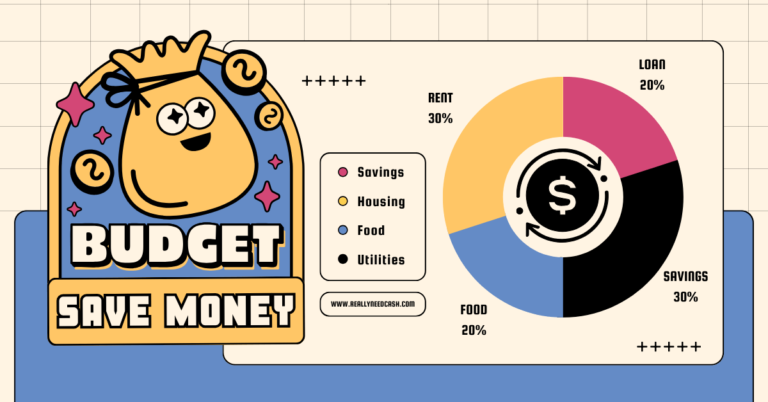To make money as an illustrator, hone your skills, build a diverse portfolio, and establish a strong online presence. Network, define your niche, and set competitive pricing. Promote your work, secure client projects, and prioritize exceptional service to cultivate long-term relationships and referrals for sustained success in the industry.

How To Make Money as an Illustrator?
Step 1: Hone Your Illustration Skills
Dedicate time to improving your artistic abilities through practice, online tutorials, and formal education. Experiment with various styles and techniques to develop a diverse portfolio showcasing your expertise.
Step 2: Build a Diverse Portfolio
Curate a portfolio that demonstrates your versatility and range, including different subject matters, styles, and mediums.
Showcase your best work, ensuring it aligns with the type of projects and clients you want to attract.
Step 3: Establish Your Online Presence
Create a professional website or online portfolio to showcase your artwork. Utilize social media platforms to share your work, engage with potential clients, and network with other artists and industry professionals.
Step 4: Network and Collaborate
Attend industry events, art fairs, and networking mixers to connect with potential clients and collaborators.
Collaborate with other artists or creative professionals to expand your reach and gain exposure.
Step 5: Determine Your Niche and Target Market
Identify a specific niche or industry where your illustrations can provide the most value.
Tailor your portfolio and marketing efforts to appeal to your target market, whether it’s children’s books, editorial illustrations, branding, or other specific areas.
Step 6: Set Your Pricing and Services
Determine your pricing structure based on factors such as your experience, the scope of the project, and industry standards.
Define the services you offer, such as custom illustrations, graphic design, or licensing existing artwork.
Step 7: Promote Your Work and Services
Utilize digital marketing strategies, such as content creation, email marketing, and SEO, to promote your illustrations and attract potential clients.
Leverage online marketplaces and freelance platforms to showcase your services and reach a broader audience.
Step 8: Secure Client Projects
Pitch your services to potential clients, including businesses, publishers, and agencies. Tailor your proposals to demonstrate how your illustrations can meet their specific needs and enhance their projects.
Step 9: Provide Exceptional Service and Deliver Quality Work
Exceed client expectations by delivering high-quality illustrations on time and within budget. Communicate effectively, incorporate client feedback, and maintain a professional demeanor throughout the project.
Step 10: Cultivate Long-Term Relationships and Referrals
Focus on building enduring relationships with clients by providing exceptional service and maintaining open communication.
Encourage satisfied clients to provide referrals and testimonials to enhance your reputation and attract new opportunities.
Key Tools for An Illustrator
To excel as an illustrator, you need to be familiar with the right tools to create your artwork. Here is a list of essential tools you should consider mastering:
- Pencil and paper: Sketching your ideas on paper is often the first step in creating an illustration. Traditional drawing materials help you refine your concept before transitioning to digital tools.
- Digital tablets: Wacom, Apple iPad, and other digital drawing tablets provide a more streamlined way to create your illustrations while maintaining a natural drawing experience.
- Graphics software: Programs such as Adobe Illustrator, Procreate, and CorelDRAW enable you to create detailed and refined digital illustrations.
- Online platforms: Utilize Behance, Dribbble, and social media to showcase your illustrations and expand your network, as well as make connections with potential clients.
| Equipment | Description |
|---|---|
| Pencil & Paper | Traditional drawing materials for sketching initial ideas |
| Digital Tablet | Essential for creating digital illustrations or refining pencil sketches |
| Graphics Software | Programs like Adobe Illustrator or Procreate help create polished digital art |
| Online Platforms | Websites like Behance and Dribbble allow you to showcase your work |
Different Types of Illustrator’s Roles
As an illustrator, you take on various roles in the creative process, depending on the project scope and clients’ needs. Some of these roles include:
- Concept Artist: Transform ideas into visual concepts, often collaborating with writers and designers.
- Storyboard Artist: Develop storyboards to guide the production of films, animations, or advertising campaigns.
- Character Designer: Create and develop original characters for books, comics, animations, or video games.
- Editorial Illustrator: Produce artworks for newspapers, magazines, and online publications, to enhance stories or articles.
- Product Illustrator: Design and illustrate packaging, merchandise, and other promotional materials for brands and businesses.
How to Become a Successful Freelance Illustrator
Building Your Portfolio
To become a successful freelance illustrator, you need to start by building your portfolio. Showcasing your work is crucial for attracting clients.
Your portfolio should include a diverse range of projects, highlighting your skills and creativity.
- Include a mix of personal projects and commissioned work (if available)
- Showcase your versatility by presenting different styles and mediums
- Use high-quality images and showcase the story behind each project
- Keep it updated with your latest work
Establishing Online Presence
Having an online presence is essential for freelance illustrators in today’s digital world. Use the following platforms to promote your work:
- Website: Create a professional website displaying your portfolio, contact information, and a brief biography. This will be your central hub for showcasing your work.
- Social Media: Utilize platforms like Instagram, Behance, and Facebook to share your work with a wider audience. Engage with fellow artists and potential clients to expand your network.
- LinkedIn: Build a professional profile on LinkedIn, highlighting your skills and accomplishments. Connect with potential clients, join industry groups, and gather recommendations from clients.
Connecting with Clients
To become a successful freelance illustrator, you need to build a steady client base. Here are some ways to connect with potential clients:
- Networking: Attend industry events, workshops, and conferences to meet potential clients and other professionals.
- Freelance Platforms: Register on websites like Upwork and Freelancer to find illustration gigs and build your reputation.
- Referrals: Ask satisfied clients for referrals, or request testimonials that you can display on your website or social media.
- Promotion: Use social media and content marketing to promote your services and showcase your expertise.
Remember to always deliver high-quality work and maintain clear communication with your clients. This will help in building long-lasting relationships and establish you as a reliable freelance illustrator.
Monetizing Your Skills and Talent
As an illustrator, you have many ways to monetize your skills and talent. In this section, we’ll discuss three major methods, Selling Your Art and Prints, Leveraging Online Platforms, and Working with Companies.
Selling Your Art and Prints
One of the most direct ways you can generate income with your illustrations is by selling your original artwork and prints. You can create and sell unique pieces like paintings, sculptures, and sketches. Additionally, you can sell prints of your work on various products, such as t-shirts and posters.
When selling prints, consider using online platforms like Redbubble and Society6. They allow you to upload your artwork and print it on a variety of products, giving you more ways to make money with your art.
Leveraging Online Platforms
Expanding your online presence can help improve income opportunities. In addition to selling prints through Redbubble or Society6, you can also:
- Offer commissions for custom artwork
- Create and sell an online course teaching your illustration techniques
- Offer services on freelance platforms like Upwork or Fiverr
By leveraging multiple platforms, you can diversify your income sources, reaching a larger audience and increasing your potential to make money.
Working with Companies
Teaming up with companies can provide stable income and new opportunities for your illustrations. Some ways you can work with companies include:
- Designing product packaging
- Creating marketing materials for ad campaigns
- Developing illustrations for educational materials
Focus on building a diverse portfolio showcasing your range of skills. This way, you become a more attractive candidate for companies in various industries. Remember to continuously improve your expertise and stay updated with in-demand skills, like CAD illustration and animation.
Monetizing your skills and talent as an illustrator involves selling your art, leveraging online platforms, and working with companies in various industries.
Marketing Strategies for Illustrators
As an illustrator, marketing your work plays a crucial role in turning your passion into a profitable venture.
By implementing effective marketing strategies, you will be able to showcase your talent and attract potential clients.
Importance of a Personal Website
Having a personal website is an essential marketing tool for any illustrator. It serves as your online portfolio where you can showcase your artwork and provide a platform for clients to reach out to you.
Make sure your website is easy to navigate, visually appealing, and contains relevant information, such as contact details and testimonials from previous clients. Be sure to update your portfolio regularly to keep it fresh and engaging.
A well-designed, up-to-date website demonstrates your professionalism and dedication to your craft.
Online Courses and Blogs
Another way to market your skills as an illustrator is to create online courses or start a blog. Platforms like Skillshare and Udemy make it easy for you to share your expertise and help others develop their talents while earning money.
If you prefer writing, starting a blog about illustration techniques and industry updates can boost your online presence.
Sharing tips, tutorials, and relevant news in your blog will help establish you as an authority in the field and attract more potential clients.
Utilizing Social Media for Engagement
Social media platforms play an essential role in boosting your online presence and promoting your work. Here are some key tactics to leverage social media effectively:
- Instagram: As a visual platform, Instagram is perfect for showcasing your illustrations. Post high-quality images, use relevant hashtags, and engage with your followers through comments and direct messages.
- Pinterest: Create boards for your illustrations and promote them on related boards to increase your visibility.
- Facebook and Twitter: Share your blog posts or illustrations and join groups or communities related to your niche for additional exposure.
Remember to interact with your audience regularly and share your work consistently to maintain their interest and help expand your reach.
By using these marketing strategies, you’ll be better equipped to grow your online presence and reach potential clients looking for talented illustrators like yourself.
Stay dedicated, consistent, and genuine in your approach, and you’ll be well on your way to success as an illustrator.
Career and Salary Perspectives in Illustration
Reality of a Freelance Illustrator’s Salary
As a freelance illustrator, your income can vary greatly depending on your experience, the projects you take on, and your ability to market yourself. In the United States, the average salary for an illustrator is around $53,522 per year, with the potential to go as high as $84,212 for experienced professionals 1.
Keep in mind that freelancing can have its ups and downs. To achieve a stable income, you’ll need to:
- Develop a strong portfolio showcasing your skills
- Market yourself effectively
- Consistently find high-quality clients
- Manage your time and workflow efficiently
Understanding Royalties and Commercial Use
In addition to your base salary, another way to earn money as an illustrator is through royalties. Royalties are typically a percentage of the revenue generated by a project that uses your artwork, such as book sales, merchandise, or digital downloads. When negotiating contracts, it’s crucial to:
- Understand the terms and conditions for the commercial use of your artwork
- Ensure your rights and compensation are clearly defined
- Keep track of your projects and royalties over time
Properly negotiating royalties can lead to a long-term, passive income stream for your work.
Prospects and Location Advantages for Illustrators
Your opportunities as an illustrator can vary depending on your location and the demand for your specific style and skills. Some areas, such as major cities like New York or Los Angeles, may have higher average salaries due to the higher demand for talented artists.
Regardless of your location, expanding your network and collaborating with other professionals in the industry can help you grow your career. Online platforms, art fairs, and industry-specific events can provide valuable networking opportunities.
By honing your skills, adapting to market trends, and building a strong network, you can increase your chances of success as an illustrator and enjoy a fulfilling career in the creative field.
Frequently Asked Questions
What are the best platforms for selling illustrations?
There are numerous online platforms where you can sell your illustrations. Some of the most popular ones include Etsy, Society6, RedBubble, Adobe Stock, and Shutterstock. These platforms cater to different types of artworks and customers, so choose the one that best aligns with your illustration style and target audience.
How to find freelance illustration jobs?
To find freelance illustration jobs, you can explore freelancing websites like Upwork, Fiverr, and Freelancer. Additionally, you can search for job postings on art-specific job boards like Behance, Dribbble, and ArtStation. Networking through social media sites, joining industry forums, and attending industry events can also help you connect with potential clients and opportunities.
How can social media boost an illustrator’s income?
Social media platforms such as Instagram, Pinterest, and Twitter can be effective in showcasing your work and building a strong online presence.
By regularly posting your illustrations, engaging with your audience, and using relevant hashtags, you can attract potential clients, connect with other illustrators, and eventually boost your income as an illustrator.
What are the most profitable niches within illustration?
Some profitable illustration niches include children’s books, editorial illustrations, advertising, packaging design, and concept art for video games and movies.
Focusing on one or more of these niches can improve your chances of securing higher-paying projects and establishing a solid reputation within your chosen field.
How to price artwork as a freelance illustrator?
Pricing artwork as a freelance illustrator depends on factors like your experience level, the complexity of the project, and the market rates within your chosen niche.
You can charge your clients on an hourly basis, assign a flat fee per project, or work on a per-illustration basis. Research market rates for your chosen niche and target clients who value your experience and skills.
What strategies can help build a successful long-term illustration career?
To build a successful long-term career as an illustrator, consider the following strategies:
- Develop and hone your illustration skills through practice, workshops, and online courses.
- Create a strong portfolio featuring your best work.
- Establish an online presence through a personal website and social media profiles.
- Network with like-minded professionals and engage with the illustration community.
- Be willing to adapt and learn new techniques and software tools as the industry evolves.
- Monitor industry trends and keep updating your portfolio to stay relevant in the competitive market.
With dedication, hard work, and persistence, you can achieve a successful long-term illustration career.







